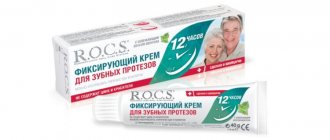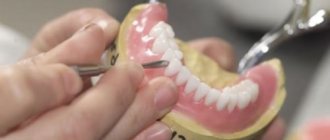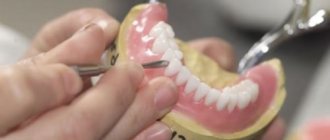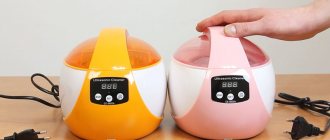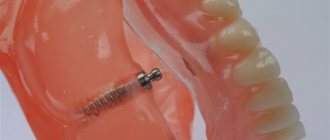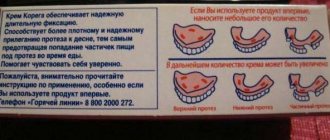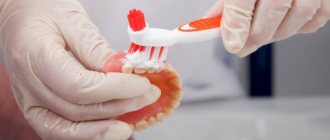May 9, 2021
Anyone may encounter a situation where they require repair of dentures fixed to the dentition. At the same time, it is not at all necessary that the structures will break down only after years of successful operation. According to WHO, about 10% of patients visit dental clinics much earlier - in the first year after installation of products. What is the cause of the problem? What defects are usually found and are all of them correctable? In what cases will devices have to be completely replaced with new ones, and when can they be repaired? This is what today's material from the editors of the UltraSmile.ru portal is about.
The most common causes of failure of orthopedic products
Problems can arise due to overloading of systems, eating too hard food, due to changes in the temperature of the food eaten (cold and hot), due to impacts and injuries, inadequate hygiene care, as well as the use of inappropriate hygiene products (highly abrasive and bleaching pastes, brushes). with hard bristles).
If defects appear after several years of wearing orthopedic devices, this may mean that the materials from which they were made have become unusable. After all, any material has its own permissible service life: for plastic, acetal, silicone, nylon - 2-5 years, for metal-plastic - 3-5 years, for ceramics - 5-7 years, for metal and metal-ceramics - about 7-10 years , for zirconium dioxide and ceramic composite – from 15 years or more.
How is the repair going?
The procedure for restoring a dental structure depends on the material from which it is made:
- To restore an acrylic prosthesis, a self-hardening resin is used. The individual sections are firmly connected, as a result of which the visibility of the transition area disappears and the previous functioning of the installation is restored.
- The clasp structure consists of different parts, in each of which a component element may break. The plastic base is restored in the same way as in the repair of an acrylic installation. An impression is taken, a replacement is made in the laboratory, and then the prosthesis is installed. A laser is used to repair a metal arch or lock. It is used to solder or weld the defective area. This type of structure cannot be repaired in a short time, since a new part is made from a cast.
- Nylon repair is a new service. If such a prosthesis broke before, a new installation was required. Modern dentistry uses building up an additional part or connecting broken ones using a bonding liquid. Crowns can be added. The repair ends with polishing and sanding the problem area.
The advantage of repairing removable structures is that you can leave the denture with the doctor for several days, and not have to be in the dental chair for several hours.
Situation No. 1: there are problems with the appearance and shape of the crown
Nature of defects
As a rule, the integrity of the outer covering of the crowns is compromised. Unsightly chips, small scratches and cracks appear on them. Some patients also complain of the structures changing color from white to yellow.
The photo shows a chipped crown
How the problem is solved
If chips and cracks occur, it is possible to repair the denture directly in the patient’s mouth. The doctor can restore the beauty and integrity of the crown using composite materials and photopolymers. Moreover, this can be easily done both with a broken piece of the crown (then it is glued in place) and without it. As for changing the shade of artificial restorations, this cannot be done by bleaching or other procedures. You can only exchange an old product for a new one if this is a very important issue for the patient.
To prevent the restorations from changing color, immediately after their installation, carefully monitor your oral hygiene, stop smoking and drinking too bright foods and drinks (for example, beets, red wine). Or initially choose crowns from materials that are least amenable to staining, for example, zirconium dioxide. And be sure to do professional hygiene 1-2 times a year.
For such problems, in most cases the crown will not need to be removed. However, if an inflammatory process has developed underneath it (caries, periodontitis, periostitis), then you will have to dismantle the structure to get to the root canals, where the infection usually “sits”, and after treatment, make and install a new one.
Fracture of clasp (metal hook)
In the dental office, the doctor takes an impression of the patient’s mouth along with the prosthesis and sends it to the dental technician in the laboratory. A plaster model is cast along with the prosthesis. The technician removes the broken clasp from the inside of the denture and bends a new one along the supporting tooth. After polymerization of the plastic, it is applied first to the site of the sawn hook, then to the outside of the prosthesis. After a short period of time, excess plastic is removed with a cutter on an electric motor, and the repair area is processed and polished, if necessary.
Problem #2: The bridge is broken
Classic bridges are permanent structures consisting of at least 3 crowns, two of which rest on the teeth remaining in the mouth, and one imitates the missing element. Bridges can also be adhesive and cantilever. These consist of a tooth-replacing crown (or several crowns) and attachments extending from it (clasps, “wings” made of fiberglass and metal tape, special inlays) that are fixed to the “supports.” These orthopedic products fail quite often.
Nature of defects
- exactly the same chips, cracks and shade changes as with conventional crowns,
- breakage, peeling off of fastening elements of adhesive and cantilever bridges,
- mobility of the bridge, formation of gaps between it and the gum,
- fracture at the base of the product.
A gap may form between the bridge and gum
How the problem is solved
In the case of chips and cracks on the crowns of the bridge, repair of dentures is carried out using composite materials. If the fasteners of adhesive structures break, then in some cases it is possible to replace them with new ones, if appropriate. For example, if the replacement crown itself was made of a durable material (ceramics, zirconium dioxide), and not of a composite.
If your composite bridge fasteners break 2 years after the start of its operation, then the material itself must be replaced. That is, in this case it is better to make a new design.
Many patients note that 3-5 years after treatment, the bridges lose stability, begin to wobble, shift, and a gap appears between them and the gum. This spoils the aesthetics of the smile and disrupts functionality. In this case, is it possible to carry out urgent repairs of dentures or their correction to correct the situation?
No, because the cause of the problems in this case is the inevitable atrophy of the bone tissue under the structure, as well as the premature destruction of the supporting teeth, which bear a serious load. And the only way out here is to remove the old devices, carry out additional therapeutic, surgical and periodontal treatment, and then install new devices, which will be made according to the changed clinical situation in the mouth.
If there is a fracture at the base of the bridge, the structure will have to be completely changed.
Repair features
Do not think that repairing removable and fixed dentures is an expensive procedure. In general, the process and price of restoration will not greatly affect the family budget, although cases are not excluded when it will be easier to order the production of new dentures than to repair old ones. In this case, you should consult your doctor at the dental clinic.
What is the procedure for restoration and repair of cracks? First of all, the specialist thoroughly cleans the product using a specialized resin, and then the damaged parts must be carefully glued together. Through this manipulation, an optimal seal is created. The result of the process and high-quality glue is a design that is no different from the new one and copes with its functional responsibilities perfectly.
Dentists react extremely negatively to attempts to independently repair removable dentures with their own hands. This is due to the fact that an ordinary person does not have the necessary professional knowledge, much less tools and materials. What could this lead to?
- To the occurrence of allergies to the use of low-quality glue;
- To change the original shape of the prosthesis, which will change the load and entail discomfort. Over time, this can lead to impaired chewing function and misalignment of the bite.
Purchasing unprofessional dental glue can lead to health problems: from “banal” stomatitis to severe intoxication.
It is important to understand that ordinary glue will not work, and this can lead to further damage to the entire structure, which means large material costs.
Problem No. 3: the removable denture has failed
Nature of defects
Removable dentures also have crowns that imitate natural teeth. They are, as a rule, made of lightweight plastic, which wears out quite quickly, chips from excessive stress, and accumulates plaque and dyes. Sometimes artificial crowns fall out of their bed, which is also a problem.
If the structure is only partially removable and is attached to the teeth remaining in the mouth using special hooks and clasps, then it is possible that the fasteners may bend, break or fail.
Another problem is that the prosthesis has become deformed, its shape has changed, the quality of its fit to the gums has changed, and it falls out of the mouth.
Often, cracks and breaks appear right at the base of such products. Naturally, most often due to inadequate load on the structure, overload of its individual areas, or consumption of solid food “beyond their control.” And also when falling from a height onto hard surfaces. Is it possible to repair removable dentures in this case? Here everything depends not only on the nature of the breakdown, but also on the material from which the device is made.
Dentures may break
On a note!
At the stage of adaptation to removable dentures and during their further use, many patients experience discomfort and think that the structures are broken. However, in reality this turns out not to be the case. It’s just that removable appliances have a number of features that you need to be prepared for from the very beginning: they can put pressure and rub the mucous membrane, under load they can stretch and deform, and without frequent corrections and adjustments by an orthopedic dentist, they begin to shift and fall out of the mouth.
How the problem is solved
With denture crowns, everything is simple: chips and cracks are repaired with a composite, fallen artificial teeth are soldered onto a bed designed for them. Doctors are also able to straighten, replace and re-solder hooks for partially removable devices if they are broken. But only on the condition that the supporting teeth are intact and can all also take on increased load. If the “supports” are destroyed, then another prosthesis must be made for a new clinical situation.
What if there is a crack in the base of the structure? This happens quite often, because removable products do not adhere well to the mucous membrane, cannot evenly distribute the chewing load, and over time begin to shift, become deformed and break.
It is most realistic to repair acrylic dentures, as well as models made from soft plastic. To repair cracks and breaks in them and restore integrity, doctors first process the broken edges with special cutters, then carefully align and glue them together, apply plastic to the joints and polymerize them using a special lamp. Then the product is ground and thoroughly polished.
Some dentures can be repaired
But if a break appears in a nylon structure, then orthopedists and technicians, as a rule, will not be able to do anything. If a naturally elastic material does break (this happens rarely; more often it stretches), it can no longer be repaired.
If there is a serious fracture at the base of the product, repairing a removable denture is almost impossible.
If the structures become mobile, shift and fall out of your mouth, then you are unlikely to need repair of removable dentures. In such a situation, it is necessary to visit an orthopedist who will reposition, correct, sharpen and adjust the products to the characteristics of the alveolar ridge, the volume and relief of which changes (decreases) over time. Do not forget that jawbone atrophy occurs under removable appliances.
Types of breakage of removable dentures
Before installing removable dentures, you should find out about their service life. For example, a regular plastic one will last about 5 years, a clasp design will last for at least 8 years, but a nylon element will last 6-7 years.
According to statistics, more than half of removable structures break before the stated warranty period. Which breakdowns are more common than others?
- Fracture or crack formation at the base;
- Malfunction of the clasp, in other words, the fastener;
- Splitting of an artificial tooth;
- Violation of fixation;
- Removing your own tooth to which the structure is attached.
Only a professional can determine the true cause.
Where to go for help
It is very important to understand where you can get your dentures repaired. As a rule, the problem should be addressed to the clinic where you had your teeth restored. And it is better to do this urgently in order to prevent larger-scale destruction of the structure and its complete failure, and bacterial plaque getting inside the chips and cracks.
You should definitely consult a doctor
Who should I go to? To an orthopedic dentist. Chips and minor defects can be corrected by the orthopedic dentist himself, but more serious damage (failure of fasteners, fractures in the base of the structure) is dealt with by dental technicians who work in the dental laboratory at the clinic. But, of course, there is usually no need to contact them directly, since all issues are resolved through the attending orthopedic doctor.
It is better to get dentures in clinics (or a network of clinics) with their own dental laboratory. Otherwise, you should not count on urgent repairs of dentures if they break. Typically, laboratories for third-party dentistry take much longer to complete orders than for their own. Thus, repairs can take several weeks or even months.
Measures to prevent breakdowns
Breakage of a denture is a big nuisance. To avoid it, you need to carefully care for the structure, handle it carefully and regularly visit an orthopedic doctor to monitor its condition. What to do at home:
- remove and thoroughly clean any stuck pieces of food;
- do not use toothpastes with a strong abrasive effect;
- buy a toothbrush with soft bristles;
- rinse after every meal, no matter whether it was a full meal or a tasting;
- remove dentures over a towel or cup of water - this reduces the risk of hitting a hard surface and, as a result, severe mechanical damage.
Even though the material used in removable denture systems is quite smooth, bacteria can also accumulate and multiply on it. To ensure optimal disinfection, special pharmaceutical products should be used. Your doctor will tell you which ones exactly.
Unfortunately, many people are now forced to resort to prosthetics. The development of dental technologies makes it possible to produce removable elements that are practically indistinguishable from natural teeth in appearance and quality. Our clinic’s specialists are highly qualified, they are always up to date with innovative developments and use only high-quality materials. Do not worry about the breakdown of the prosthetic structure - with us you can get prompt assistance from an orthopedic dentist at an affordable price.
Why you can't do repairs at home
Some people are not at all interested in where they can glue a denture in case it breaks or chips. They try to carry out the restoration on their own, at home, and sometimes with office and household adhesives. This is unacceptable, since non-specialized adhesive compositions are unsafe for health and can lead to intoxication of the body and allergic reactions. In addition, they can corrode elements of an artificial structure.
“After installation, my grandfather started rubbing his prosthesis; there was supposedly a sharp edge that dug into his gums. So a neighbor on a bench near his house advised him to cut it himself. The grandfather did not consult with anyone and carried out this plan alone... And then his gums began to hurt terribly and all his gums became inflamed, he could not wear a denture at all and could not chew either. For three months I sat on soups and broths alone. The doctor was horrified when he saw his grandfather's work. He said that we’ll cure the gums, but we’ll have to install a new prosthesis after such an amateur performance...”
M_Dmitry, fragment of a review from the site gidpozubam.ru
At home, it is impossible to properly process the edges of the fault and make them smooth. As a result, the structure will rub and injure the tissues with which it comes into contact. Home repairs can permanently damage your prosthesis, disrupting its aesthetics and functionality. The result of this will be the need to undergo re-prosthetics.
Notice
: Undefined variable: post_id in
/home/c/ch75405/public_html/wp-content/themes/UltraSmile/single-item.php
on line
45 Notice
: Undefined variable: full in
/home/c/ch75405/public_html/wp-content /themes/UltraSmile/single-item.php
on line
46
Rate this article:
( 3 ratings, average: 5.00 out of 5)
prosthetics
- Afanasyeva V.V., Lebedenko I.Yu., Grachev D.I., Arutyunov S.D. Increasing the efficiency of restoration of removable plate dentures after breakage // Russian Dental Journal. – 2014.
Expert “The reasons for the breakdown of prostheses are not always related to the patient’s mistakes made during use. Devices can fail early if they were initially poorly manufactured and installed incorrectly. Or in cases where the supporting teeth began to decay or become loose, the gums became inflamed, and bone tissue atrophied. And in such situations, what is needed is not repair of dentures, but their correction or even complete replacement according to the new clinical situation. As well as treatment from other specialists, for example, from a dental therapist.” Orthopedic dentist Sambuev Bair Sergeevich
Consulting specialist
Sambuev Bair Sergeevich
Specialization: Orthopedic dentist Experience: 11 years
Why you can't make repairs yourself
If you fix a breakdown yourself, you can ruin your health. Because:
- Clinics, workshops and laboratories use hypoallergenic substances, resins, and glue. They are specially designed for the oral cavity to avoid irritation of the mucous membrane. Household glue is a toxic product.
- With unprofessional intervention, the shape of the structure may change, as a result, comfortable use will disappear, diction will change, the gums will become inflamed, and the supporting teeth will begin to loosen.
- Some repair work requires only qualified intervention. If a crown breaks off or a part of it breaks off, it is impossible to securely secure it in its original place. This also applies to a broken clasp.
Considering the above, it follows that repairing removable dentures is necessary only in the clinic. Home structural repairs can have a negative impact on human health.
Comments
What if my prosthesis breaks six months after the prosthesis? Who will pay me for the pleasure of repairing or replacing it? Isn't it the clinic itself?
Maria Ivanovna (05/27/2021 at 00:35) Reply to comment
- Dear Maria Ivanovna, if the case is within the scope of the warranty and service provided in the contract with the clinic, then, yes, the repair or replacement of the prosthesis will be carried out at the expense of dentistry. Typically, orthopedic products are provided with a warranty for a period of 1 to 3-5 years (each clinic individually, not to be confused with the service life of prostheses!). If during this period the prosthesis breaks due to the fault of the clinic specialists, for example, it was poorly manufactured and installed, then the patient can count on free repairs and replacement. At the same time, it is very important that the patient observes all the conditions under which the warranty obligations will be fulfilled, and does not try to repair the prosthesis on his own or in a third-party organization. Otherwise, the clinic has the right to refuse to provide free services.
Reply from the author of the article (05/30/2021 at 09:18) Reply to comment
Hello. Tell me what can cause a removable denture to become deformed (not crack) and how long does it take to restore such a denture? And what kind of food is considered super hard to avoid damage.
Olga Ivanovna (07/08/2021 at 08:22) Reply to comment
What to do if the denture rubs the gums? About a month of using the prosthesis passed and it began to rub the gums and, accordingly, it became painful to bite.
Olga (07/08/2021 at 09:50) Reply to comment
Hello. I had prosthetic teeth in one clinic, but after 8 months the prosthesis broke. I went to another clinic to have the prosthesis repaired or a new one made. But the doctor said that a new one was needed, since the prosthesis was made from low-quality materials. The previous clinic said that they were made of metal, but in fact it turned out that they were made of metal-plastic. The clinic where I did it initially is not there. But there was a 1 year warranty. Please tell me how to identify a prosthesis, what it is made of, and what to do in this situation.
Alexey (07/08/2021 at 11:33) Reply to comment
My mother’s dentures are becoming unusable, but she is in no hurry to change them yet, since this is not a cheap procedure, although she feels discomfort. Tell me, is it dangerous for the integrity to delay this or not?
Ekaterina (07/08/2021 at 11:57 am) Reply to comment
I must admit, at first I thought about false plastic dentures. But no, this is about metal ceramics. Tell me, what percentage of patients with crowns turn to orthopedists with a similar problem?
Lesya (07/08/2021 at 12:10) Reply to comment
Due to injury, the face has a displacement in the jaw area. Tell me, please, can a prosthesis be made in full accordance with the broken symmetry? And won’t there be discomfort in the future, because there are a lot of movements during the day?
Denis (04.08.2021 at 16:24) Reply to comment
If a metal-ceramic crown begins to change color, does this indicate that it is deteriorating, or is the problem purely aesthetic? Will replacing the product directly harm the tooth?
Sonya (08/04/2021 at 18:19) Reply to comment
Tell me, I have a metal-ceramic crown. Recently, under the crown, I have noticed that the gums have darkened. This indicates that it is time to change the crown, has it become unusable? Perhaps there is an option for cleaning the gums under the crown? Or is it a gum problem?
Maria (08/05/2021 at 12:07 pm) Reply to comment
Write your comment Cancel reply
What to do if the prosthesis breaks?
If your denture breaks:
- You should not throw it away, even if it seems that the defect cannot be repaired.
- You need to carefully collect and place in a dry container all the broken elements.
- Then you should contact the dentist who performed the prosthetics and make an appointment, stating the purpose of the visit.
As a rule, a patient with a broken prosthesis is scheduled to see an orthopedist in the near future. Already in the clinic, the dentist examines the structure and informs whether repair is possible.
Advantages of dental prosthetics in Moscow from Denta-Labor:
Working for many years, our dental laboratory has become a center of excellence in the production of dentures in Moscow. Services are provided with the most favorable conditions:
- a wide range of work - from repairing prostheses to urgent production of new ones;
- reasonable prices - we save by receiving consumables and equipment directly from manufacturers;
- high professionalism - we can handle work of any complexity;
- innovation and technical innovations - we use equipment from well-known manufacturers (for example, KaVo and Renfert).
If you are tired of enduring discomfort, dial our number +7 (495) 162-08-25 , and we will advise you and tell you the approximate cost of making dentures. We approach your problems individually!
How are structures repaired in a dental laboratory?
It all depends on the specific case of failure, however, in general, the process can be represented as follows:
- For cracks and fractures of dentures, special self-hardening compounds are used, a layer of polymer is applied on top and polished;
- For chips, composite materials are used, applied in layers;
- Lost artificial teeth are restored using high temperatures (ceramics), or they are built up if they are plastic;
- The clasp is disassembled - the arch is separated from the artificial gum with teeth, the fallen parts are welded with a laser and reassembled.
Cost of dental prosthetics
| Name | Price from |
| Clasp clasp prosthesis | 42000 rub. |
| Clasp locking prosthesis (1 jaw) | 42000 rub. |
| Removable nylon denture (1 jaw) | 38000 rub. |
| Removable acrylic beam prosthesis with implant fixation | 120,000 rub. |
| Removable prosthesis Quattro Ti (quadrotti) – Italy (1 jaw) | 45000 rub. |
| Quattro Ti microprosthesis (quadrotti) – Italy (1 jaw) | 45000 rub. |
| Full or partial removable plate denture (acrylic, 1 jaw) | 30,000 rub. |
| Full or partial removable acrylic denture with frame | 35000 rub. |
| Full or partial removable acrylic denture | 30,000 rub. |
| Complete removable plate denture with locking fixation “Uni” | 40,000 rub. |
| Locking system “Uni” | 10,000 rub. |
| Complete removable plate denture with locking fixation “Uni” with frame | 45000 rub. |
| Temporary immediate – prosthesis from 1 to 4 teeth – acrylic | 17000 rub. |
| Temporary immediate prosthesis from 1 to 4 teeth – nylon | 20,000 rub. |
| Individual spoon | 2000 rub. |
| Telescopic crown | 15000 rub. |
| Conditionally removable denture on telescopic crowns (1 jaw) | 60,000 rub. |
| Clinical relocation – upper jaw | 7500 rub. |
| Relining the ALL-ON-4 prosthesis | 12000 rub. |
| Clinical relocation – lower jaw | 7500 rub. |
| Therapeutic mouthguard | 4000 rub. |
| Positioner, splint (kappa) | 25000 rub. |
| Repairing a prosthesis | 3000 rub. |
| Cleaning the prosthesis | 500 rub. |
| Full reinforcement of the upper jaw | 10,000 rub. |
| Welding 1 tooth | 3000 rub. |
| Prosthesis correction | 3000 rub. |
| Strengthening the prosthesis with reinforcement (partially) | 10,000 rub. |
| Metal-ceramic crown (CoCr) “STANDARD” | 10,000 rub. |
| Metal-ceramic crown (CoCr) “Premium class” | 14000 rub. |
| Crown on a gold alloy frame + alloy cost | 14000 rub. |
| Temporary crown (clinical) | 3000 rub. |
| Collapsible stump inlay (cobalt - chrome) | 6500 rub. |
| Collapsible stump inlay (gold) (excluding the cost of precious metal) | 7500 rub. |
| Stump inlay with locking fastening “Uni” | 9000 rub. |
The entire price list for implantation.

